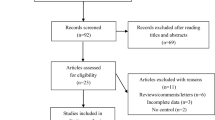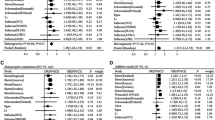Abstract
With great interest, we read the paper “Polymorphisms in IL-4/IL-13 pathway genes and glioma risk: an updated meta-analysis” (by Chen PQ et al.) [1], which has reached important conclusions about the relationship between polymorphisms in interleukin (IL)-4/IL-13 pathway genes and glioma risk. Through quantitative analysis, the meta-analysis found no association between IL-4/IL-13 pathway genetic polymorphisms and glioma risk (Chen et al. in Tumor Biol 36:121–127, 2015). The meta-analysis is the most comprehensive study of polymorphisms in the IL-4/IL-13 pathway and glioma risk. Nevertheless, some deficiencies still exist in this meta-analysis that we would like to raise.
Similar content being viewed by others
Avoid common mistakes on your manuscript.
Firstly, we think that there are some deficiencies in the literature search. The investigators (Chen PQ et al.) only searched the literature from PubMed, Embase, Web of Science, and the Cochrane Library without any time restrictions [1]. This strategy, we think, would bring a great bias to the results. In our experience, a more comprehensive search should include Cochrane-controlled Trials Register, Medline, SCOPUS, Science Citation Index, CBM database, CNKI, Wanfang database, and some certain specialty databases. Meanwhile, the investigators also did not describe the real search strategy and the manual search protocol. We suggest that the investigators provide us the real search strategy and a clear manual search protocol.
Secondly, the investigators assessed the methodological quality of the respective studies based on a set of criteria modified from previous research (Online Resource 1) [2, 3]. However, the investigators did not provide us the real content of the quality assessment criteria. Therefore, we could not understand what the quality scores that ranged from 0 to 10 meant, respectively. To make the methodological quality more understandable, the investigators should describe the real content and the quality scores of the quality assessment criteria.
Thirdly, the investigators made the meta-analysis for nine polymorphisms in IL-4/IL-13 pathway genes (Table 2). However, the genotype of IL-4 rs 2243248 and IL-4 rs 2243250, the OR (95 % CI) of IL-4R rs 1805011 and IL-4R rs 1805012 were all missing in Table 2. We hope that investigators could provide the missing data or make some reasonable explanations for the incomplete data in Table 2.
Finally, the I 2 for the IL-4 rs2243248 was 75 %, which indicates a significant heterogeneity. The investigators just explained that the publication bias was the source of heterogeneity. To make the meta-analysis more credible, the investigators should list more possible reasons for the heterogeneity and perform a sensitivity analysis.
Thanks go to the authors for their contribution in supplying us with an assessment of the relationships between nine polymorphisms in interleukin (IL)-4/IL-13 pathway genes and glioma risk. However, considering the limited number of studies, in the future, studies with larger sample sizes, standardized unbiased homogenous patients, and well matched controls are required to draw more comprehensive conclusions.
References
Chen PQ, Chen C, Luo C, et al. Polymorphisms in IL-4/IL-13 pathway genes and glioma risk: an updated meta-analysis. Tumor Biol. 2015;36:121–7.
Al-Moundhri MS, Al-Nabhani M, Al-Bahrani B, Burney IA, AlMadhani A, Ganguly SS, et al. Interleukin-1beta gene (IL-1B) and interleukin 1 receptor antagonist gene (IL-1RN) polymorphisms and gastric cancer risk in an Omani Arab population. Gastric Cancer. 2006;9(4):284–90.
Gao LB, Pan XM, Li LJ, Liang WB, Zhu Y, Zhang LS, et al. RAD51 135G/C polymorphism and breast cancer risk: a meta-analysis from 21 studies. Breast Cancer Res Treat. 2011;125(3):827–35.
Author information
Authors and Affiliations
Corresponding author
Ethics declarations
Conflicts of interest
None
Rights and permissions
About this article
Cite this article
Wang, TT., Li, JM. & Zhou, D. Note of the methodological flaws in the paper entitled “Polymorphisms in IL-4/IL-13 pathway genes and glioma risk: an updated meta-analysis”. Tumor Biol. 37, 199–200 (2016). https://doi.org/10.1007/s13277-015-4570-0
Received:
Accepted:
Published:
Issue Date:
DOI: https://doi.org/10.1007/s13277-015-4570-0




